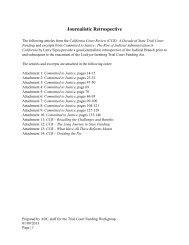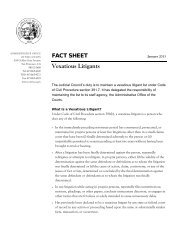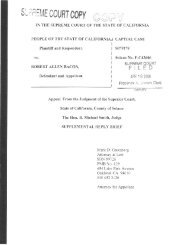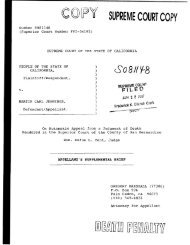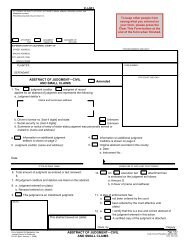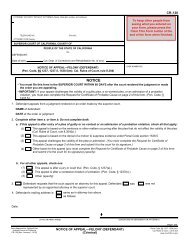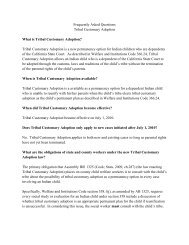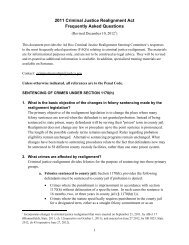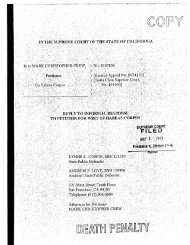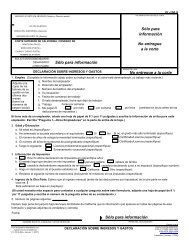Appellant, William Satele, Reply Brief - California Courts - State of ...
Appellant, William Satele, Reply Brief - California Courts - State of ...
Appellant, William Satele, Reply Brief - California Courts - State of ...
Create successful ePaper yourself
Turn your PDF publications into a flip-book with our unique Google optimized e-Paper software.
speculative as appellant's-- all <strong>of</strong>these deliberations and decisions occurred within<br />
the course <strong>of</strong>fifty minutes. (38CT 10941-10944, 18RT 4497-4403.)<br />
Thus, respondent's argument, based on People v. Ledesma (2006) 39<br />
Cal.4th 641, that "[d]efendant provides no reason for us to doubt that the jury in<br />
this case was able to follow the court's instructions" has no application here<br />
because there is strong evidence that the jury could not have resolved all <strong>of</strong> these<br />
issues in fifty minutes. Furthermore, Ledesma is distinguishable because it<br />
addressed completely different issues. In Ledesma the jury was informed it had to<br />
start deliberations anew after one <strong>of</strong> its members was replaced. The issue in<br />
Ledesma was whether the entire panel had to be discharged during the penalty<br />
phase after the court found misconduct on the part <strong>of</strong> one juror requiring his<br />
removal. Thus, in Ledesma the misconduct <strong>of</strong>the one juror was not related to the<br />
ability <strong>of</strong> the rest <strong>of</strong> the jury to deliberate fairly and fully. In contrast, here the<br />
incorrect instruction was given to the entire newly constituted jury. The language<br />
from Ledesma quoted by respondent referred to the fact that the defendant had<br />
suggested no reason why the rest <strong>of</strong> the jury had to be discharged, as the<br />
misconduct was only related to one juror. It is not relevant here.<br />
<strong>Appellant</strong> has shown two reasons why the error should be regarded as<br />
prejudicial. First, the error in instruction in this case was directed to the entire<br />
jury. Second, the extremely brief period that the new jury deliberated in relation<br />
to the numerous questions that it had to resolve is a very strong indication that the<br />
specific error - the failure to tell the jury to begin deliberation anew - created a<br />
situation where the jury did not in fact begin deliberations from the start.<br />
Respondent refers to the instructions given relating to lingering doubt, the<br />
"mercy instruction," and a "sympathy instruction," all given at the request <strong>of</strong><br />
appellants, as noted by respondent. Respondent notes that the Alternate Jurors 2<br />
and 4 were present when these instructions were given. Therefore, respondent<br />
contends the juror were instructed within the meaning <strong>of</strong>People v. Cain (1995) 10<br />
Cal.4th 1. (RB at pp. 220-221.)<br />
123



